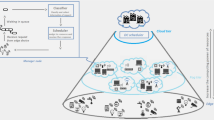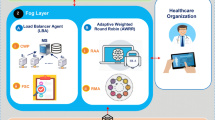Abstract
The huge amount and diversity of data generated by Internet of Things (IoT) devices and the need to store and process this data led to the development of fog computing alongside cloud computing. Fog computing is a new paradigm for providing service at the edge of the network and close to end users, so that it can support real-time IoT applications. Because fog involves heterogeneous and distributed infrastructure with limited resources, so efficient resource allocation to satisfy Quality of Service (QoS) is challenging. IoT application placement mechanisms have been developed to address these issues, in which the subordinate services of these applications are mapped to fog nodes. Despite extensive research to solve the Service Placement Problem (SPP) in fog computing, efforts are still ongoing due to the importance of the issue. Hence, this paper proposes an efficient and autonomous mechanism for solving SPP using Teaching Learning-Based Optimization (TLBO) called SPP-TLBO. SPP-TLBO is a multi-objective QoS-aware algorithm that manages resources on distributed and localized fog domains. In addition to the above, we improve the performance of TLBO by configuring the evolution process with a shared parallel architecture. Besides, SPP-TLBO can save more resources to handle future requests by considering application deadlines and extracting the dynamic distribution of resources required over time. The proposed algorithm is evaluated by simulation on a synthetic fog environment. The simulation results show that SPP-TLBO improves system performance and is between 8 and 19% better efficiency compared to some advanced methods such as CSA-FSPP, FSP-ODMA and, WOA-FSP.










Similar content being viewed by others
Data availability
Data sharing not applicable to this manuscript as no datasets were generated or analyzed during the current study.
References
Gaurav A, Psannis K, Peraković D (2022) Security of cloud-based medical internet of things (miots): a survey. Int J Softw Sci Comput Intell (IJSSCI) 14(1):1–16
Chiang M, Zhang T (2016) Fog and IoT: an overview of research opportunities. IEEE Internet Things J 3(6):854–864
Tarahomi M, Izadi M, Ghobaei-Arani M (2021) An efficient power-aware VM allocation mechanism in cloud data centers: a micro genetic-based approach. Clust Comput 24:919–934
Huang S, Zong G, Wang H, Zhao X, Alharbi KH (2023) Command filter-based adaptive fuzzy self-triggered control for MIMO nonlinear systems with time-varying full-state constraints. Int J Fuzzy Syst. https://doi.org/10.1007/s40815-023-01560-8
Li X, Liu Y, Ji H, Zhang H, Leung VC (2019) Optimizing resources allocation for fog computing-based internet of things networks. IEEE Access 7:64907–64922
Zhao Y, Niu B, Zong G, Zhao X, Alharbi KH (2023) Neural network-based adaptive optimal containment control for non-affine nonlinear multi-agent systems within an identifier-actor-critic framework. J Franklin Inst 360(12):8118–8143
Wu W, Xu N, Niu B, Zhao X, Ahmad AM (2023) Low-computation adaptive saturated self-triggered tracking control of uncertain networked systems. Electronics 12(13):2771
Santos J, Wauters T, Volckaert B, De Turck F (2021) Reinforcement learning for service function chain allocation in fog computing. Commun Netw Serv Manag Era Artif Intell Mach Learn. Wiley, Devon, United Kingdom, pp 147–173
Toczé K, Nadjm-Tehrani S (2018) A taxonomy for management and optimization of multiple resources in edge computing. Wirel Commun Mob Comput 2018:23–47
Guo S, Zhao X, Wang H, Xu N (2023) Distributed consensus of heterogeneous switched nonlinear multiagent systems with input quantization and DoS attacks. Appl Math Comput 456:128127
Djemai T, Stolf P, Monteil T, Pierson J M (2019) A discrete particle swarm optimization approach for energy-efficient IoT services placement over fog infrastructures. In: 2019 18th international symposium on parallel and distributed computing (ISPDC). IEEE, pp 32–40
Tang F, Wang H, Zhang L, Xu N, Ahmad AM (2023) Adaptive optimized consensus control for a class of nonlinear multi-agent systems with asymmetric input saturation constraints and hybrid faults. Commun Nonlinear Sci Numer Simul 126:107446
Zhang H, Zou Q, Ju Y, Song C, Chen D (2022) Distance-based support vector machine to predict DNA N6-methyladenine modification. Curr Bioinform 17(5):473–482
Cao Y, Xu N, Wang H, Zhao X, Ahmad AM (2023) Neural networks-based adaptive tracking control for full-state constrained switched nonlinear systems with periodic disturbances and actuator saturation. Int J Syst Sci 54(14):2689–2704
Cheng F, Niu B, Xu N, Zhao X, Ahmad AM (2023) Fault detection and performance recovery design with deferred actuator replacement via a low-computation method. IEEE Trans Autom Sci Eng. https://doi.org/10.1109/TASE.2023.3300723
Farahbakhsh F, Shahidinejad A, Ghobaei-Arani M (2021) Multiuser context-aware computation offloading in mobile edge computing based on Bayesian learning automata. Trans Emerg Telecommun Technol 32(1):e4127
Sun W, Liu L, Memon AG, Zhou X, Zhao H (2020) Waveguide-based fluorescent immunosensor for the simultaneous detection of carbofuran and 3-hydroxy-carbofuran. Biosensors 10(12):191
Zhong Y, Chen L, Dan C, Rezaeipanah A (2022) A systematic survey of data mining and big data analysis in internet of things. J Supercomput 78(17):18405–18453
Tan J, Liu L, Li F, Chen Z, Chen GY, Fang F, Zhou X (2022) Screening of endocrine disrupting potential of surface waters via an affinity-based biosensor in a rural community in the Yellow river Basin China. Environ Sci Technol 56(20):14350–14360
de Souza FR, de Assunçao MD, Caron E (2019) A throughput model for data stream processing on fog computing. In: 2019 international conference on high performance computing & simulation (HPCS). IEEE, pp 969–975
Ayoubi M, Ramezanpour M, Khorsand R (2021) An autonomous IoT service placement methodology in fog computing. Softw Pract Exp 51(5):1097–1120
Rao RV, Savsani VJ, Vakharia DP (2011) Teaching–learning-based optimization: a novel method for constrained mechanical design optimization problems. Comput Aided Des 43(3):303–315
Liu C, Wang J, Zhou L, Rezaeipanah A (2022) Solving the multi-objective problem of IoT service placement in fog computing using cuckoo search algorithm. Neural Process Lett 54(3):1823–1854
Zhao D, Zou Q, Boshkani Zadeh M (2022) A QoS-aware IoT service placement mechanism in fog computing based on open-source development model. J Grid Comput 20(2):1–29
Ghobaei-Arani M, Shahidinejad A (2022) A cost-efficient IoT service placement approach using whale optimization algorithm in fog computing environment. Expert Syst Appl 200:117012
Faraji-Mehmandar M, Jabbehdari S, Javadi HS, H. (2021) A proactive fog service provisioning framework for Internet of Things applications: an autonomic approach. Trans Emerg Telecommun Technol 32(11):e4342
El Kafhali S, Salah K (2017) Efficient and dynamic scaling of fog nodes for IoT devices. J Supercomput 73(12):5261–5284
Naha RK, Garg S, Chan A, Battula SK (2020) Deadline-based dynamic resource allocation and provisioning algorithms in fog-cloud environment. Futur Gener Comput Syst 104:131–141
Yousefpour A, Patil A, Ishigaki G, Kim I, Wang X, Cankaya HC, Jue JP (2019) Fogplan: a lightweight QoS-aware dynamic fog service provisioning framework. IEEE Internet Things J 6(3):5080–5096
Gill SS, Garraghan P, Buyya R (2019) ROUTER: fog enabled cloud based intelligent resource management approach for smart home IoT devices. J Syst Softw 154:125–138
Natesha BV, Guddeti RMR (2021) Adopting elitism-based genetic algorithm for minimizing multi-objective problems of IoT service placement in fog computing environment. J Netw Comput Appl 178:102972
Ramzanpoor Y, Hosseini Shirvani M, Golsorkhtabaramiri M (2022) Multi-objective fault-tolerant optimization algorithm for deployment of IoT applications on fog computing infrastructure. Complex Intell Syst 8(1):361–392
Kishor A, Chakraborty C, Jeberson W (2021) A novel fog computing approach for minimization of latency in healthcare using machine learning. Curr Trends Intell Multimed Process Syst 6(7):2021
Al-Tarawneh MA (2022) Bi-objective optimization of application placement in fog computing environments. J Ambient Intell Humaniz Comput 13(1):445–468
Shahidinejad A, Abbasinezhad-Mood D (2022) Ultra-lightweight and secure blockchain-assisted charging scheduling scheme for vehicular edge networks by utilization of NanoPi NEO. IEEE Trans Veh Technol 71(8):8116–8123
Xue B, Yang Q, Xia K, Li Z, Chen GY, Zhang D, Zhou X (2022) An AuNPs/mesoporous NiO/nickel foam nanocomposite as a miniaturized electrode for heavy metal detection in groundwater. Engineering. https://doi.org/10.1016/j.eng.2022.06.005
Skarlat O, Nardelli M, Schulte S, Borkowski M, Leitner P (2017) Optimized IoT service placement in the fog. SOCA 11(4):427–443
Gonnade PG, Aher PB (2013) A scope of implementation of parallel algorithms using parallel computing toolbox. Int J Adv Res Comput Sci 4(11):182–186
Cheng F, Liang H, Niu B, Zhao N, Zhao X (2023) Adaptive neural self-triggered bipartite secure control for nonlinear MASs subject to DoS attacks. Inf Sci 631:256–270
Zhang H, Zhao X, Wang H, Zong G, Xu N (2022) Hierarchical sliding-mode surface-based adaptive actor–critic optimal control for switched nonlinear systems with unknown perturbation. IEEE Trans Neural Netw Learn Syst. https://doi.org/10.1109/TNNLS.2022.3183991
Cao C, Wang J, Kwok D, Cui F, Zhang Z, Zhao D, Li MJ, Zou Q (2022) webTWAS: a resource for disease candidate susceptibility genes identified by transcriptome-wide association study. Nucleic Acids Res 50(D1):D1123–D1130
Masdari M, Gharehpasha S, Ghobaei-Arani M, Ghasemi V (2020) Bio-inspired virtual machine placement schemes in cloud computing environment: taxonomy, review, and future research directions. Clust Comput 23(4):2533–2563
Wang T, Zhang L, Xu N, Alharbi KH (2023) Adaptive critic learning for approximate optimal event-triggered tracking control of nonlinear systems with prescribed performances. Int J Control. https://doi.org/10.1080/00207179.2023.2250880
Acknowledgements
This work was supported in part by the Xuzhou Science and Technology Innovation Project under Grant KC19061, in part by Jiangsu Province Modern Education Technology Project under Grant 2021-R-92384, in part by Jiangsu University Foundation funded project (2020SJA1059), and in part by the Xuzhou Medical University Funded Project under Grant 2018KJ01 and Xjy201820.
Author information
Authors and Affiliations
Contributions
YS, HW, DW, and MG-A conducted this research. YS: model design, analysis, interpretation, and writing original draft. HW: formal analysis, implementation, and project administration. DW: supervision, conceptualization, and writing review. MG-A: software, methodology, implementation, and writing review.
Corresponding authors
Additional information
Publisher's Note
Springer Nature remains neutral with regard to jurisdictional claims in published maps and institutional affiliations.
Rights and permissions
Springer Nature or its licensor (e.g. a society or other partner) holds exclusive rights to this article under a publishing agreement with the author(s) or other rightsholder(s); author self-archiving of the accepted manuscript version of this article is solely governed by the terms of such publishing agreement and applicable law.
About this article
Cite this article
Sha, Y., Wang, H., Wang, D. et al. A multi-objective QoS-aware IoT service placement mechanism using Teaching Learning-Based Optimization in the fog computing environment. Neural Comput & Applic 36, 3415–3432 (2024). https://doi.org/10.1007/s00521-023-09246-w
Received:
Accepted:
Published:
Issue Date:
DOI: https://doi.org/10.1007/s00521-023-09246-w




